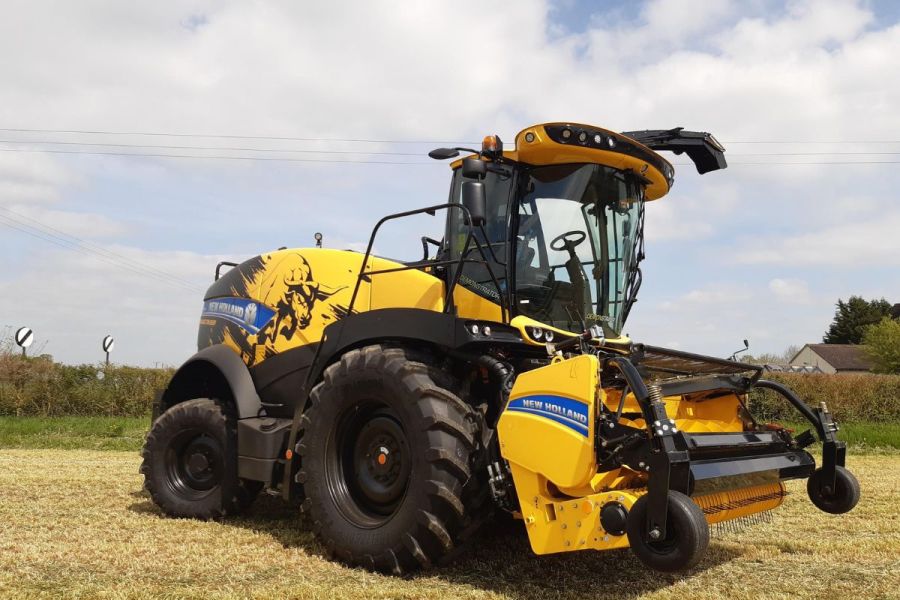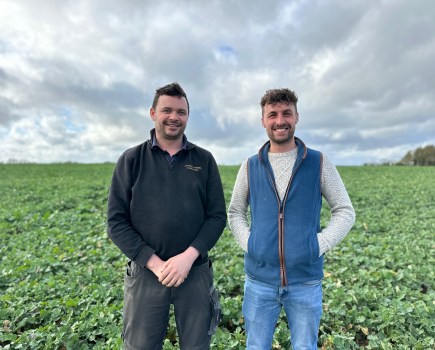The demand for forage harvesters isn’t slowing down and as improving productivity becomes more important, the demand has risen for more high-tech machines. CPM takes a look at a number of different options on the market.
By Melanie Jenkins
Whether forage harvesters are being used for silage production or for anaerobic digesters, the demands on them haven’t decreased. Below are some of the latest options available.
Fendt
First introduced in 2013, Fendt’s Katana is currently available as either a 650 or 850 model, both Gen3. The 650 has a V8 straight six engine, and the 850 has a six-cylinder 18.3-litre Liebherr engine producing 847hp.
One of the biggest points about these machines is their six feed rollers which are designed to provide good, consistent chop quality, explains Fendt’s Dan Woodward. “The metal detector spans the 930mm from the drum, so that nothing will get past it.”
Drums are available with 20, 28 or 40 knives – with the latter aimed at the biogas market – providing a chopping range of 2.6mm up to 42.3mm.
“The Gen3 models have a greatly improved crop flow compared with previous models,” says Dan. “Everything from the pendulum frame backwards has been changed.”
The pendulum frame itself now has more rotation, able to rotate 14° up and down the field. In addition, the feed rollers have been changed slightly to reduce maintenance, and although the drum is the same, the rollers are easier to take off. “It used to take 20 minutes and now it only takes five,” he says.
To provide a more consistent cut and to reduce wear, the knife sharpening system now adjusts as it goes across the blades, rather than at either end, explains Dan. “Instead of winding down at either end, which resulted in the end knives being sharpened more than the central ones, the stone is adjusted all the way across.”
Fendt has gone away from using a hydraulically folding corn cracker and Gen3 models now come in two variants with 300mm rollers. The first variant is the R, where the cracker gears are intermeshed with one another to produce a straight but, and the second is the RS which is a helical shape and will shred crops.
The spout is now bigger and longer with better extension, so it can reach 6.8m, says Dan. “With increased height and a flap angle – so it can flow straight into the trailer at 90° – there’s full control and it can be set to remain at the centre of the trailer.”
Both machines come with several fuel tank variants, includes a 1430-litre diesel only option, with a 190-litre AdBlue at the rear of the chassis. A further option consists of a 1215-litre diesel tank and a 215-litre tank for an additive.
For working on steep banks or uneven fields, the forager is equipped with a balanced grip system which transfers torque to the wheels that require it, says Dan. “If the upper wheels start to slip, power will be reduced to those and move it to the lowers ones, helping to save the sward and reduce compaction.”
Krone
Krone’s range of self-propelled foragers aim to deliver high efficiency and chop quality in all forage crop types, with operator comfort and handling key to machine designs across eight power ratings, according to Ben Davies of Krone UK.
“Starting with engine output, Krone’s BiG X is available from 480hp to 630hp with a 63cm width chopping drum, while the higher horsepower models, from 680hp to 1180hp, features a wider 80cm chopping drum to maximise throughput.”
The pendulum tube system, seen across the full range of BiG X foragers, allows operators to easily swap headers depending on crops being harvested, he says. “This includes grass, whole crop and maize, along with providing lateral float on uneven ground.
“For grass crops, the camless EasyFlow 300 S header has up to 58% fewer moving parts than conventional pick-up systems. This helps reduce maintenance costs and downtime, operating faster for a clean crop pick-up and increased productivity.”
When it comes to cutting whole crop, Ben explains that the XDisc 620 header is designed to take in high volumes, mirroring the technology seen in Krone’s range of disc mowers. “In terms of maize headers, we have the choice of either the lightweight simple technology and low input power EasyCollect available with cutting widths of 7.5m, 9.0m and 10.5m. Or there’s the variable-row harvesting with rotating sickle discs XCollect available with either 7.5m or 9.0m cutting width.”
Ben says crop transition into the machine is via six hydraulically driven feed rollers, which compress the crop into a uniform mat prior to it entering the drum.
Full width metal detection along with RockProtect is fitted to all machines as standard in the UK to protect the forager from damage caused by metal or stones. “The width and feed roll configuration ensures the crop is fed evenly into the drum for a uniform and consistent chop quality.”
Chop length can be adjusted from the cab by altering the speed of the feed rollers, depending on dry matter content and the requirements of the ration. The faster the crop is fed into the forager, the longer the crop length.
The drums are available with 20, 28, 36 or 40 blades, with the high blade count better suited for customers chopping maize for biogas, requiring a much finer chop quality.
To maintain continuous and smooth crop flow, Ben explains that Krone’s foragers feature a spring-loaded plate beneath the chopping drum and VariStrem- a discharge accelerator rotor.
“Compared with a standard fixed plate, the system is designed for blockage-free and smooth operation, even in varying volumes of crop. The technology allows operators to utilise the forager to its limit and use less fuel per hour,” says Ben.
For maize and whole crop, the material then flows through the 30% speed differentiated 123/144 250mm or 125/150 305mm serrated tooth OptiMaxx crop conditioner for optimal digestibility. The gap between the rollers can be easily adjusted from the cab depending on the crop.
Krone also offers a unique VariQuick system, a chain drive that moves the conditioner out of or into the crop flow in just a few minutes, for simple changeover between grass and wholecrop or maize.
“Crop throw can be controlled from the cab by adjusting a flap on the rear wall of the crop accelerator to suit the filling situation, which is referred to as StreamControl. This allows operators to adjust the throw more easily, depending on the filling situation. As the accelerator requires less power to blow a short distance, the operator can free up engine output and use it for chopping and more throughput.
To automatically adapt engine output to working harvest conditions, Krone has developed PowerSplit engine technology, says Ben. “Eco Power and X Power options for low and high output provide operators with full flexibility to optimise fuel economy.
“The transversely mounted engine allows the entire crop flow and vehicle drivetrain components, to take the engine power directly off poly V-belts, maximising overall efficiency and with a separate belt to drive the intake rollers and the header it allows them to be reversed irrespective to the chopping drum being engaged or not.”
In terms of digital offering, all BiG X foragers are fitted with Krone smart telematics to provide agronomic and operational data as well as remote diagnostics for after sales support.
EasyLoad supports operators in automatically filling trailers to capacity from either side or the rear, GPS guidance, crop volume and constituent measurement are optionally available.
New Holland
New Holland’s FR650 ‘The Beast’ forage cruiser includes a number of features such a consistent chop length and quality due to having the widest feed channel on the market and a thin crop mat, says New Holland’s Siôn Whittingham.
“The FR650 has the largest diameter cutting cylinder on the market, which allows for high inertia and capacity. Drum configurations consist of 2×10, 2×12, 2×16 and 2×20 knives, with all able to have maize or grass knives fitted to allow for best cutting performance in various crops,” he explains.
Auto sharpening in forward and reverse comes as standard, including with auto shearbar adjustment. It can be activated from the cab with fingertip command, providing consistent cut, saving engine power and fuel, says Siôn.
The forager has a double drive system, meaning users can independently control the header auger speed to the feedroll speed to provide greater flexibility and performance of feeding various crops smoothly into the cutterhead.
New Holland’s MetaLoc is included, whereby an electronic metal detector feedroll will stop the feeding if an object is detected. This will stop within 300 milliseconds to protect internal components from damage.
Crop analysis is assessed using the NIR sensor (Nutrisense), he explains. “It records crop quality live, reporting details on dry matter, protein, starch, acid detergent fibre, neutral detergent fibre and ash – which allows for management of subsequent processes.”
Mapping of information is done in real-time and includes information on moisture, yield or other data used for managing the farming processes, he adds.
Automation functions help to remove stress from the operator and include, PowerCruise II, which optimises capacity to the engine load and fuel consumption. Machine maximises throughput to parameters set by the operator, boosting productivity and saving fuel.
IntelliFill means that the side or rear filling of trailers is left to the software, meaning the operator doesn’t have to divert attention to this.
It’s available in five models, the FR480, 550, 650, 780 and the 920 models, and has an FPT Cursor 16-litre Stage V engine.
The FR650 ‘The Beast’ has been undertaking a demonstration tour around the country this season, says Siôn. “The feedback from the tour was very positive and customers were pleasantly surprised by how well the FR650 performed against their own machine.
“Some of the key points that impressed the customers were the chop length consistency, how well it coped with lumpy wet grass, having plenty of power and torque to deal with heavy swaths of grass.
“The longer spout was a big plus to operators as it allowed a safer gap between the forager and tractor and trailer,” he adds.
This article was taken from the latest issue of CPM. Read the article in full here.
For more articles like this, subscribe here.
Sign up for Crop Production Magazine’s FREE e-newsletter here.




